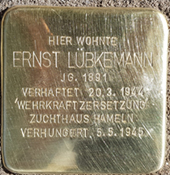Search for Names, Places and Biographies
Already layed Stumbling Stones
Suche

Ernst Lübkemann * 1891
Hoppenstedtstraße 59 (Harburg, Eißendorf)
HIER WOHNTE
ERNST LÜBKEMANN
JG. 1891
VERHAFTET 20.3.1944
"WEHRKRAFTZERSETZUNG"
ZUCHTHAUS HAMELN
VERHUNGERT 5.5.1945
Ernst Boye Rikos Lübkemann, born on 16 Oct. 1891 in Verden/Aller, detained in the Hameln penitentiary, deceased due to the consequences of imprisonment on 5 May 1945
Hoppenstedtstrasse 59 (Harburg District, Eissendorf quarter)
Ernst Lübkemann, born on 16 Oct. 1891 in Verden/Aller, arrived in Harburg with his parents in about 1895 and attended the eight-grade elementary school (Volksschule) there as well. As a young man, he moved to East Friesland and worked there in Emden as a senior municipal inspector until the mid–1920s. His profession was that of a merchant. Since 1930, Harburg was once again his permanent place of residence.
In 1913, Ernst Lübkemann had married Bernhardine Johanne, née Voget. From 1920 to 1923, he belonged to the national liberal German People’s Party (Deutsche Volkspartei). In these economically difficult times, he set up his own company specializing in cleaning central heating boilers. It operated all over Northern Germany and seems to have had great financial problems. In the following years, several lawsuits were brought against him for unpaid taxes and health insurance contributions.
In Mar. 1944, Ernst Lübkemann was staying in Hildesheim. In a tobacco shop, whose owner he knew from earlier visits, he made "statements against National Socialist rule.” The merchant by the name of Kuhberg, who was also Nazi Party (NSDAP) cell leader, denounced him and bore witness to the statement "The leader is a madman.” Ernst Lübkemann was arrested at the hotel. The trial against him took place on 23 Nov. 1944 before the Berlin Court of Appeal (Kammergericht), which handed down a sentence of five years in a penitentiary. On 31 Dec. 1944, he was transferred to the Hameln penitentiary.
In the Hameln penitentiary, designed for 400 inmates, there were by then 1,300 prisoners without sufficient food and medical care. In the last days of the war, many political prisoners were murdered by order of the Nazi party district leader. On 5 Apr. 1945, some of the prisoners were "evacuated”; it was actually a death march to the Holzen/Eschershausen subcamp. When American troops liberated the Hameln penitentiary on 7 Apr. 1945, they found only prisoners who could no longer get up from their flatbeds without help, individuals whom even doctors could hardly help. One of these persons was Ernst Lübkemann. He died on 5 May 1945 in the Hameln city hospital; he had starved to death.
Translator: Erwin Fink
Kindly supported by the Hermann Reemtsma Stiftung, Hamburg.
Stand: June 2020
© Margrit und Helmut Rüth
Quellen: StaH 351-11_9919; Adressbuch Hamburg 1940; Matthias Heyl und Margit Maronde-Heyl: Harburger Opfer des Nationalsozialismus

